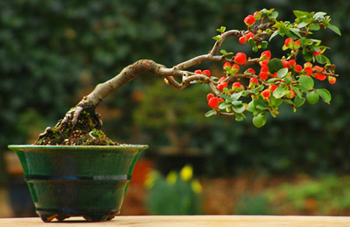
The Flowering Quince Bonsai Tree, scientific name Chaenomeles speciosa, is native to eastern Asia in Japan, China, and Korea. This is one of my favorite trees for bonsai.
This deciduous shrub produces gorgeous pink, red, or white flowers and fragrant yellowish fruits.
Fruit is editable but tart, and can be used for jelly making. Flowering Quince can be made into a beautiful bonsai tree.
Additional Information
Family: Rosaceae
Scientific name: Chaenomeles specios,
Common Names: Flowering Quince, Japanese Flowering Quince, Red Flowering Quince, Pink Flowering Quince, Quince
Origin: Native to China and eastern Asia.
Appearance: Flowering Quince is a thorny shrub with alternately arranged and simple leaves. New leaves have a reddish color that matures into a deep, shiny green.
Flowering: During spring, produces pink, red, white, cream salmon or orange flowers that are followed by fragrant yellowish fruits.
Outdoor/Indoor Use: Both.
Light Requirements: It likes full sun to partial shade. You should expose it to full sun for full bloom and for the fruit to set.
Water Requirements: Likes moist but well-drained soil. Needs daily watering during the growing season in the summer and less watering during the winter months. This is a drought-tolerant shrub.
Pruning/Training: Cut off all blooms unless you want the tree to produce fruit. During fall, prune new growing leaves to two nodes. Suckers should be eliminated so they don’t take up sunlight and nutrients from the main tree. Suckers are also susceptible to pests and diseases, such as aphids. Remove them unless you need them for styling.
Bonsai Style: Flowering Quince can be used in styles that require multiple stems, such as five-trunk, cascade, semi-cascade, clumps, root-linked, raised-root, and raft styles.
Fertilizing: After the tree is done blooming apply well-balanced fertilizer every two weeks.
Repotting: Needs to be repotted every two years during the fall months. Use neutral to slightly low pH soil. Regular bonsai soil mix will work.
Hardiness: Does well in the USDA Zone 4 or 5-8.
Insects and Diseases: Some of the problems can come from mites, scales, aphids, and leaf spots.
Propagation: By seeds, grafting, cuttings, and layers.
Buy Flowering Quince Bonsai Tree »




